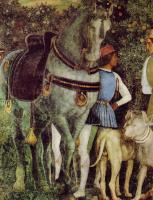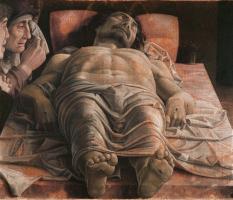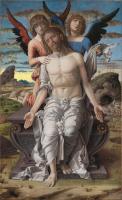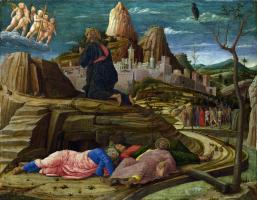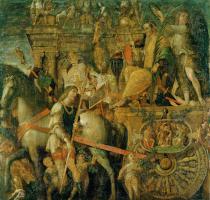Andrea Mantegna
For over half a century Andrea Mantegna was probably the most influential painter of Northern Italy. His work is characterized by decisive line, subdued colour, and a highly skilled use of perspective, which gives it depth and reality. He was a master of the foreshortened figure. His father was a carpenter, but at an early age the boy was apprenticed to and legally adopted by a painter in Padua, a highly cultured city with one of the oldest universities in Europe. By 1448, aged seventeen, Mantegna had become an independent master.
 When Mantegna was a young man, there was a huge interest around the North
Italian city of Paduain the collection and study of Roman antiquities. Mantegna
knew many of the university scholars and antiquitarians involved in the work,
and what he learned from them he frequently reproduced throughout his art. In
turn, his paintings produced a growing interest in the revival of the classical
forms. Throughout his career, he made frequent references to Roman style of
bas-relief as shown with Caesar himself in the epic suite The Triumph of
Caesar.
When Mantegna was a young man, there was a huge interest around the North
Italian city of Paduain the collection and study of Roman antiquities. Mantegna
knew many of the university scholars and antiquitarians involved in the work,
and what he learned from them he frequently reproduced throughout his art. In
turn, his paintings produced a growing interest in the revival of the classical
forms. Throughout his career, he made frequent references to Roman style of
bas-relief as shown with Caesar himself in the epic suite The Triumph of
Caesar.
There are three surviving paintings by him on the subject of St Sebastian, a Roman soldier who was sentenced to death by the Emperor Diocletian for his belief in Christianity. Sebastian was topical because he was traditionally appealed to for protection from the plague, which was rife in Mantegna’s time. His martyrdom was a popular subject as it allowed the artist to concentrate, with all due piety, on the near naked male figure. For Mantegna it was also an excuse to demonstrate his scholarly passion for the ruins of ancient Rome.
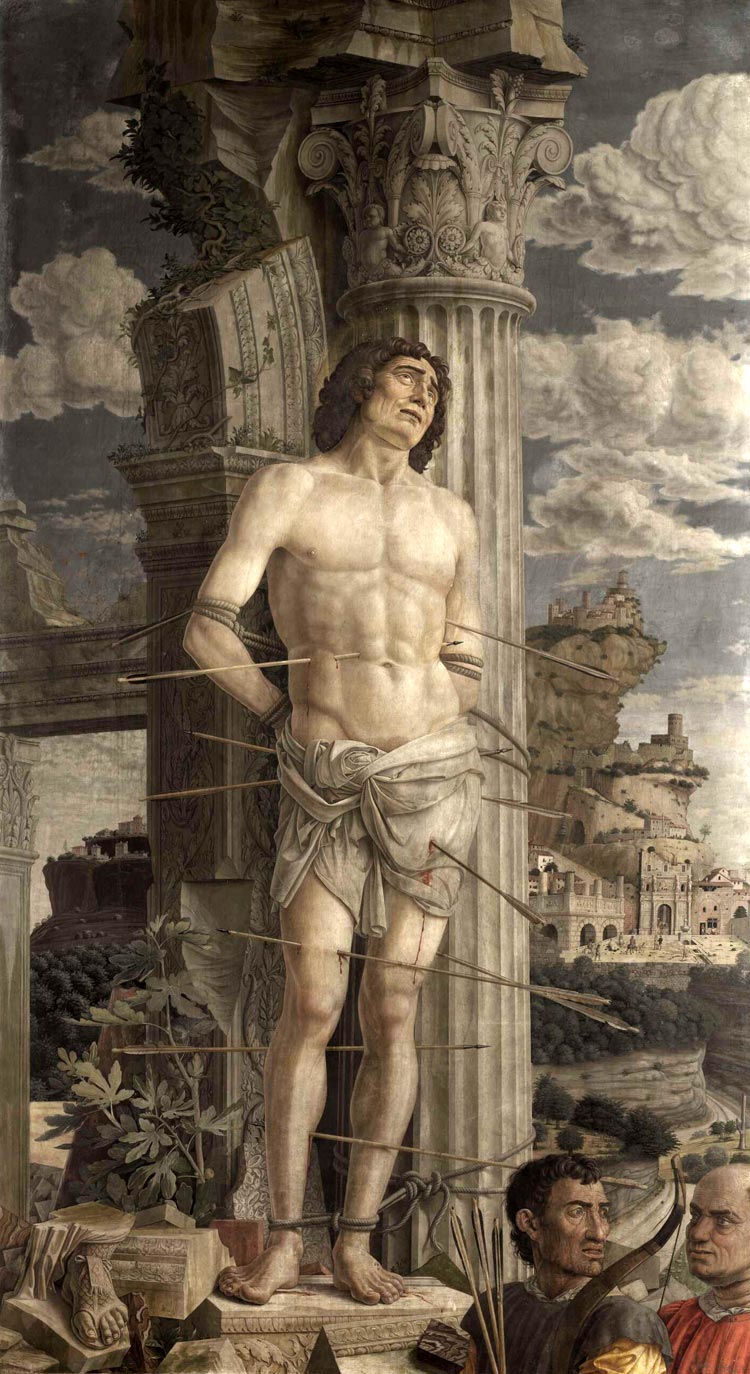 The figure of Sebastian is stone-like and sculptural, reminiscent of ancient
Roman statues, and in spite of the arrows piercing the flesh, and the rivulets
of blood, it has a feeling of strength and dominance. Parallel to his feet is a
remnant of a Roman statue, a carved stone foot in a stone sandal. Sebastian’s
arms and feet are tied to a fluted column, part of an ancient Roman temple.
The figure of Sebastian is stone-like and sculptural, reminiscent of ancient
Roman statues, and in spite of the arrows piercing the flesh, and the rivulets
of blood, it has a feeling of strength and dominance. Parallel to his feet is a
remnant of a Roman statue, a carved stone foot in a stone sandal. Sebastian’s
arms and feet are tied to a fluted column, part of an ancient Roman temple.
There is a wealth of detail in the imaginary classical background : magnificent ruins perched precipitously on rocky crags, with a fortified town on the topmost peak, and fantastic stylized clouds floating overhead. The painting has an austere but undeniable grandeur, and it is easy to understand why princes and potentates vied to own the work of Mantegna.
 Mantegna has frames this confined space in a way that architecturally defines
it as the cell of a morgue; and, trained has he was in the study of classical
models, he conveys an impression of austerity with his Christ figure. His
mastery of foreshortening also ensures that whatever the angle of approach, the
viewer encounters the pierced feet. The draperies are sharply defined, painted
— it is said — from Mantegna’s models of folded paper and gummed
fabric.
Mantegna has frames this confined space in a way that architecturally defines
it as the cell of a morgue; and, trained has he was in the study of classical
models, he conveys an impression of austerity with his Christ figure. His
mastery of foreshortening also ensures that whatever the angle of approach, the
viewer encounters the pierced feet. The draperies are sharply defined, painted
— it is said — from Mantegna’s models of folded paper and gummed
fabric.
 The frescoes in the Camera degli Sposi (Bridal Chamber) of the ducal palace in
Mantua are striking examples of fifteenth century illusionism.
The frescoes in the Camera degli Sposi (Bridal Chamber) of the ducal palace in
Mantua are striking examples of fifteenth century illusionism.


